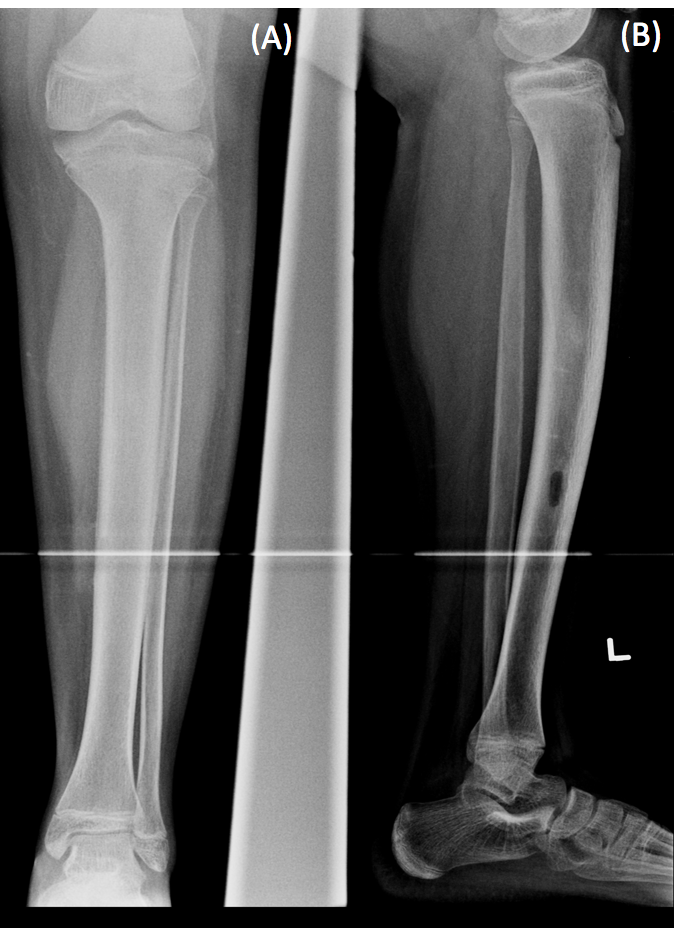Peer Reviewed
Idiopathic Intramedullary Osteosclerosis
Authors:
Syed A. A. Rizvi, PhD, MS, MBA
Hampton University School of Pharmacy, Hampton, Virginia
Zafar Qureshi, MD; Javeria Waseem, MBBS; Rodel Reyes, MD; and Mohammad N. Manzoor, BS
UHI CommunityCare Clinic, Miami, Florida
Mileydis Alonso, MS-IV
Nova Southeastern University, Fort Lauderdale, Florida
Citation:
Rizvi SAA, Qureshi Z, Waseem J, Reyes R, Manzoor MN, Alonso M. Idiopathic intramedullary osteosclerosis. Consultant. 2019;59(8):250-251.
A 15-year-old boy presented with persistent pain in the mid left leg for the past 3 weeks. The pain was associated with a limp and sometimes awoke him from sleep. The patient’s mother noted swelling in his left leg with increased warmth. The patient was taking ibuprofen or acetaminophen at night to help him sleep, and she denied any history of surgery or trauma in the boy.
Physical examination. The patient was afebrile with stable vital signs. The patient’s blood pressure was 115/60 mm Hg, heart rate was 83 beats/min, respiratory rate was 22 breaths/min, height was 159 cm, and weight was 60.3 kg, for a body mass index of 23.85 kg/m2. Physical examination findings were significant for mild edema and exquisite point tenderness to palpation over the midshaft area of the left lower leg. Range of motion was normal. All other examination findings were noncontributory.
Diagnostic tests. Laboratory test results were unremarkable. Radiography findings were abnormal (Figure); thus, the case was discussed with a pediatric orthopedist, and magnetic resonance imaging (MRI) with and without intravenous contrast was obtained.

Figure. Anterior (A) and lateral (B) view radiographs of the left tibia showing intramedullary osteosclerosis and endosteal thickening.
The MRI findings revealed bone marrow signal alteration within the left mid to distal tibial diaphysis. The alteration was concerning for osteomyelitis, with an irregular intramedullary area of thick peripheral-rim nodular enhancement and central hypoenhancement measuring 3.2 × 1.1 × 1.1 cm. These findings were concerning for intramedullary abscess.
The patient underwent an incisional biopsy of the left tibia, and the sample was sent for pathology examination. The lesion consisted of preexisting cancellous bone and marrow with abundant reactive woven bone formation, edema, and fibrosis. Some of the woven bone had prominent osteoblastic rimming. There was no neoplasm, infection was ruled out by negative cultures, and the changes were consistent with idiopathic intramedullary osteosclerosis.
Discussion. Idiopathic intramedullary osteosclerosis (a term introduced by Abdul-Karim and colleagues1) is a very rare presentation of abnormal bone growth in the medullary cavity of long bones.2 It usually affects the lower extremities (mostly the tibia), monomelic or bilateral, with a female predilection and no associated family history or skeletal disorders. In most cases, this disorder is discovered via radiography in patients with a history of leg pain that intensifies with physical activity.1-3
There is no known cause or specific treatment for this rare condition, and it is a diagnosis of exclusion. Radiographs reveal homogeneous sclerosis that is usually limited to the medullary cavity with unaffected or minimally thickened cortex and with possible adjacent soft-tissue swelling.3,4
The differential diagnosis of intramedullary osteosclerosis is usually made after imaging and pathology studies, and by excluding other conditions such as osteosarcoma, osteomyelitis, trauma, bone dysplasias, and lack of periosteal reaction.5,6 Only 2 known conditions, Camurati-Engelmann disease and Ribbing disease, show particularly similar radiographic imaging and bone scintigraphy features to that of intramedullary osteosclerosis, but they can easily be ruled out given that both are genetic conditons.7-9 However, Camurati-Engelmann disease is autosomal dominant, while Ribbing disease is autosomal recessive. Both conditions can be ruled out with proper laboratory and histologic studies.9-11
Several treatment options have been used to address the pain associated with intramedullary osteosclerosis, including reaming of the medullary canal12 and drug treatment with nonsteroidal anti-inflammatory drugs and glucocorticosteroids.11 Our patient is taking ibuprofen and doing very well.
- Abdul-Karim FW, Carter JR, Makley JT, et al. Intramedullary osteosclerosis: a report of the clinicopathologic features of five cases. Orthopedics. 1988;11(12):1667-1675.
- Casagranda B, Heller MT, Costello J. Intramedullary osteosclerosis: an incidental sclerotic lesion in a trauma patient. Radiol Case Rep. 2013;8(4):878.
- Ihde LL, Forrester DM, Gottsegen CJ, et al. Sclerosing bone dysplasias: review and differentiation from other causes of osteosclerosis. Radiographics. 2011;31(7):1865-1882.
- Chanchairujira K, Chung CB, Lai YM, Haghighi P, Resnick D. Intramedullary osteosclerosis: imaging features in nine patients. Radiology. 2001;220(1):225-230.
- Puranik AD, Singh N, Maheshwari S, Gupta N, Wali P. Intramedullary osteosclerosis of right femur confirmed on triphasic bone SPECT/CT in a patient with equivocal radiological features. Indian J Nucl Med. 2016;31(1):39-41.
- Balkissoon ARA, Hayes CW. Case 14: intramedullary osteosclerosis. Radiology. 1999;212(3):708-710.
- Kaftori JK, Kleinhaus U, Naveh Y. Progressive diaphyseal dysplasia (Camurati-Engelmann): radiographic follow-up and CT findings. Radiology. 1987;164(3):777-782.
- Shier CK, Krasicky GA, Ellis BI, Kottamasu SR. Ribbing’s disease: radiographic-scintigraphic correlation and comparative analysis with Engelmann’s disease. J Nucl Med. 1987;28(2):244-248.
- Skiadas V, Tyllianakis M, Zolota V, Karantanas A. Intramedullary osteosclerosis. Am J Orthop. 2012;41(11):496-499.
- Seeger LL, Hewel KC, Yao L, et al. Ribbing disease (multiple diaphyseal sclerosis): imaging and differential diagnosis. AJR Am J Roentgenol. 1996;167(3):689-694.
- Janssens K, Vanhoenacker F, Bonduelle M, et al. Camurati-Engelmann disease: review of the clinical, radiological, and molecular data of 24 families and implications for diagnosis and treatment. J Med Genet. 2006;43(1):1-11.
- Kang S, Han I, Shin SH, Kim H-S. Orthopaedic case of the month: lower leg pain in a 41-year-old woman. Clin Orthop Relat Res. 2012;470(1):321-326.


